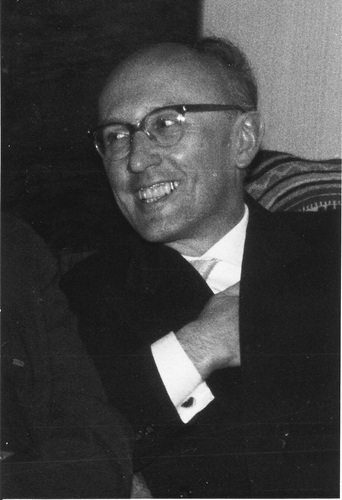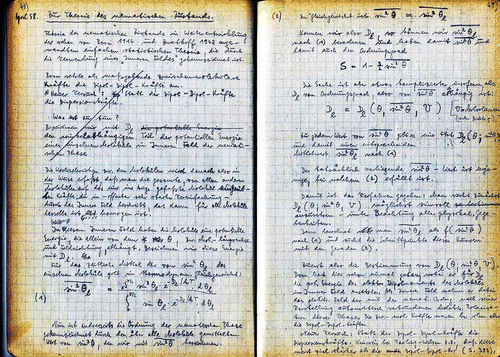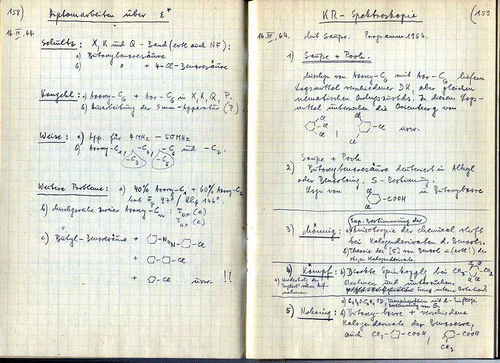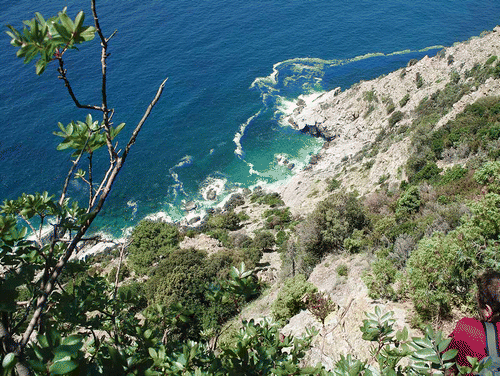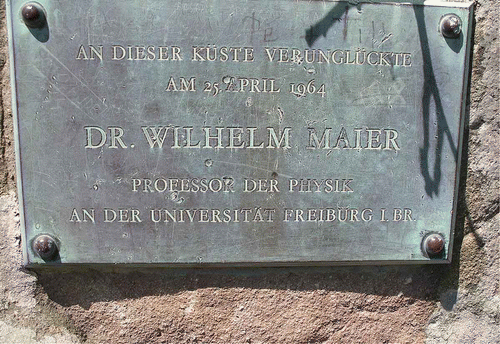Abstract
The Maier–Saupe theory is one of the most successful descriptions of the liquid crystalline state. While Saupe is a familiar name in liquid crystal research, his doctoral supervisor Wilhelm Maier is lesser known. We still remember Wilhelm Maier, even 100 years after his birth.
In 1958 in the July edition of the science journal Zeitung fuer Naturforschung, a two-page article with the title Simple Molecular Theory of the Nematic Liquid Crystalline State by W. Maier and A. Saupe, Institute of Physical Chemistry and Physics, University of Freiburg i. Br., appeared. [Citation1]
Who were the authors Wilhelm Maier and his PhD student Alfred Saupe? In the liquid crystal community, the name of Alfred Saupe (1925–2008) is well established for his numerous works.
His PhD supervisor Wilhelm Maier, however, is mostly forgotten (). In commemoration of his 100th anniversary his name should be recalled.
Freiburg i. Br. und Halle/Salle (until 1945)
Wilhelm Maier was born on 3 October 1913 in Villingen, Baden. After receiving his secondary school diploma, he started to study physics, mathematics and mineralogy at the University of Freiburg i. Br. in the summer term 1932. Being an assistant at the Institute of Physics, he began his PhD work in the field of liquid crystals with Wilhelm Kast as his supervisor. Kast, who had been famous for his swarm theory of liquid crystals for a long time, was appointed Professor in Halle/Saale in 1937. In July 1937, Wilhelm Maier followed him as assistant at the Institute of Experimental Physics.
In Halle, he finished his dissertation which he had begun in Freiburg and received his doctorate on the 10 November 1937. The topic of his PhD work was The Field Dependence of the Dielectric Constant of p-Azoxyanisol.
During Second World War, Wilhelm Maier had to work on the orders received by the Institute of Physics from the Wehrmacht (amongst others on dielectrics, ultra sound transmitters, microphones). However, he could also continue working in the field of his own research, namely the molecular structure of liquid crystal phases, and habilitated in Physics on the 20 June 1943. The topic of his habilitation thesis was The Dielectic Anisotropy of Crystalline Liquids. He made meticulous notes of his results and intellectual considerations in a series of notebooks, which he wrote in gothic script in Halle and in Latin script later in Freiburg.
During his activities in Halle, Wilhelm Maier used azoxyanisol and chemically related compounds that had high transition temperatures (melting points and clearing temperatures all above 100°C), which made his research rather laborious. He received several compounds from Conrad Weygand [Citation2] who worked on liquid crystals as an organic chemist in Leipzig [Citation10]. The existence of the considerable collection of liquid crystal preparations from the time of Daniel Vorlaender, which had been stored at the Halle Institute of Chemistry, apparently stayed undiscovered for Wilhelm Maier and his Head of Department, Kast. More than 1000 preparations were rediscovered by Horst Sackmann [Citation8] only in 1957. [Citation3] His first doctoral student Heinrich Arnold used them to conduct the groundbreaking phase mixture research of smectic phase polymorphy [Citation7].
Wilhelm Maier’s extensive investigations of dielectricity constants of liquid crystals, as well as of the influence of magnetic fields and their behaviour under ultrasound, are described in detail in his diary notebooks during his work in Halle. He noted the construction of the apparatus for measuring dipole moments, which he apparently took to Freiburg later.
Wilhelm Maier’s activities in Halle came to an abrupt end after the occupation of the city by the US army in April 1945. According to the Yalta agreement, the territories around Halle, Leipzig and Jena were assigned to the Soviet occupation zone. Before the arrival of the Soviet army in June 1945, the Americans transported all scientists from Halle, Leipzig and Jena to the US occupation zone [Citation6]. The scientists were allowed to take all scientific documents with them. That is why the notes about Wilhelm Maier’s activities in Halle were preserved. He himself was transported to the region near Darmstadt and after Second World War, just like other deported scientists, he was left to care for himself. In spring 1946, he returned to the heavily destroyed city of Freiburg.
Again in Freiburg i. Br. – 1946–1953 at the Institute of Physics
From May 1946, Wilhelm Maier was a lecturer of Physics at the University of Freiburg and worked as an assistant of Wolfgang Gentner during the restoration of the Institute of Physics, which had been heavily destroyed during the war. There, he founded the Department of Molecular Physics. The main topic of his research was the dependence between molecular structure and intermolecular interactions. He used a range of physical measurement techniques such as dielectric measurements, ultrasound absorption, spectroscopic methods (UV, IR, NMR, ESR) and microwave spectroscopy. His first notes about his work on ‘crystalline liquids’ in Freiburg are dated to May 1948, when he wrote about ‘the continuation of dielectric investigations’ which had apparently been started in Halle. Already by that time, he used the concept of the mean field which is to play the central role in his later theory.
In 1952, Wilhelm Maier was appointed as extraordinary professor.
Freiburg – 1953–1964 at the Institute of Physical Chemistry
Wilhelm Maier’s Department of Molecular Physics played an outsider role at the Institute, where nuclear physics was pursued under Wolfgang Gentner’s supervision. In 1953, there came an opportunity to change to the position of an externally funded lecturer at the Institute of Physical Chemistry. The Head of Department was Reinhard Mecke, the internationally acknowledged pioneer and expert of molecular spectroscopy, a patriarch, who was feared for his domineering style of leadership [97]. Due to the excellent facilities at the Institute, Wilhelm Maier could substantially extend his work on liquid crystals by Raman and infrared spectroscopy.
Additionally to his liquid crystals research, he was engaged together with a microwave spectroscopy research group (Heinz Dieter Rudolph, later in Ulm, and Helmut Dreizler, later in Kiel) in the investigation of physical properties of ‘free’ molecules which was like breaking fresh ground at that time.
In 1956, Wilhelm Maier met Sir Chandrasekhara Venkata Raman, who visited the Institute on the invitation of Reinhard Mecke. Raman presented his theory of crystal spectra with euphoric enthusiasm. [Citation6] Wilhelm Maier, seated to his left, was looking sceptically, apparently not sharing Raman’s conception ().
Figure 2. Wilhelm Maier (seated left) with Sir Raman (seated right) in the Institute of Physical Chemistry, Freiburg, 1956 (photograph by W. Lüttke).
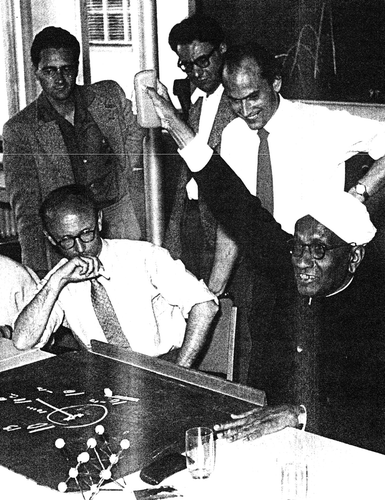
In 1962, Wilhelm Maier was offered a full professor position at the Department of Physical Chemistry of Kiel University and also a Chair of Physics at the Technical University in Darmstadt. As the University of Freiburg offered him a full professorship in the Department of Physics, he decided to stay in Freiburg.
The path to a theory of nematic liquid crystals
Which theoretical attempts were known to Wilhelm Maier? Already since 1948 he worked on what is called the ‘mean field’, which was already mentioned by Max Born in his theory developed in 1916 [Citation7], which is based on dipole–dipole interactions. Based on his knowledge of materials, Wilhelm Maier realised that solely permanent dipoles cannot be the reason for the formation of the nematic phase. Further, according to Born, (simple) liquid crystals should be ferroelectric, which could not be confirmed. W. Zwetkoff [Citation8] introduced the order parameter S in 1942 as follows:
Due to his numerous investigations, Wilhelm Maier realised that if a large enough anisotropy of the polarisability of molecules is present, intermolecular dispersion–interactions alone can account for the stability of nematic ordering. Repulsive forces were in the first instance neglected. On this basis, he developed – together with his doctoral student Alfred Saupe – a theory of the nematic phase which is accepted up to this date. In his diary of April 1958, we can read his first entry entitled: Zur Theorie des nematischen Zustandes (On the theory of the nematic state), . The second paragraph is crossed out with the question What is there to do?. On many pages, he develops meticulously the theoretical approach, where also paragraphs are deleted, or the word Unsinn (nonsense) written on the margin together with large question marks.
As a result remains the temperature dependence S(T) which coincides well with his experimentally determined data. The theory predicts a first-order transition for nematic to isotropic, also as found experimentally (). Critically he notes that the assumption of a spherical symmetric molecular arrangement represents an illegitimate simplification, which is corrected later. Elaborate accounts of his theory can be found in two publications from 1959/1960, [Citation9,Citation10] in which the predictions of the theory are verified by experimental data. Despite certain objections, [Citation11] it should be pointed out that the Maier–Saupe theory is unsurpassed to this day.
Figure 4. Data S(T) from reference [Citation11].
![Figure 4. Data S(T) from reference [Citation11].](/cms/asset/9b521db3-ab93-4e5d-a863-5f915079c2c8/tlcy_a_860680_f0004_b.gif)
1964: the tragic end of a life for science
On 16 March 1964, Wilhelm Maier summarised the research programme for the year 1964 in his diary, which investigates on nuclear magnetic resonance spectroscopy he was planning to do with his co-workers, Saupe and Nehring, and which diploma thesis topics he wanted to assign to new postgraduates ().
Four weeks later he was dead ….. What had happened?
In April 1964, Wilhelm Maier was invited to give a talk at the University of Pisa. Subsequently, he travelled to the Ligurian coast into the Cinque Terre, where he wanted to rest and hike for a few days. There, at a rocky cliff close to Levanto (), he found his death on 25 April 1964. He was a very good mountaineer who should have had no problems climbing down the rocks to the sea. Fishermen found the dead directly at the beach….
His wife however reported that her husband was a non-swimmer. The cause of his tragic death was never revealed …. At its place a commemorative plaque () reminds of this reluctant, cheerful and empathetic scientist and didactically gifted university teacher who had to leave by far too early ().
Acknowledgements
As a young doctoral student, the author of this paper had the pleasure to experience Wilhelm Maier as a sympathetic and amicable person. He thanks Maier’s former co-workers for valuable advice: Heinz Dieter Rudolph, Ulm, Helmut Dreizler, Kiel, and especially Gerhard Meier, Freiburg, who saved the scientific inheritance of Wilhelm Maier (which will be made accessible at the archive of the Karlsruhe Institute of Technology after being processed by the author) from disposal.
Translated from German by Anna Belonogova and Ingo Dierking.
References
- Maier W, Saupe A. Z. Eine einfache molekulare Theorie des nematischen kristallinflüssigen Zustands. Naturforsch. 1958;13a:564.
- Beyer L, Hoyer E. Chemische Wegzeichen. Von Goethes Morphologie zum Flüssigkristall-Bildschirm, Conrad Weygands Beiträge zur chemischen Morphologie, S. 217. Passage-Verlag:Leipzig; 2008.
- Stegemeyer H. Professor Horst Sackmann, 1921–1993. Liq Cryst Today. 1994;4:1–2. doi:10.1080/13583149408628630.
- Arnold H, Sackmann HZ. Isomorphiebeziehungen zwischen kristallin-flüssigen Phasen. Elektrochem. 1959;63:1171.
- Wiemers G. Vor 50 Jahren. Die Amerikaner verlassen Leipzig. Leipziger Universitäts-Z. 1995;5:19.
- Lüttke W, Nonnenmacher GAA. Reinhard Mecke (1895–1069) – Scientific work and personality. J Mol Struct. 1995;347:1–17. doi:10.1016/0022-2860(95)08532-Z.
- Born M. Sitzungs-Ber. Königl. Preuß. Akad. Wiss. Phys.-Math. Kl, Part 1, 1916;614.
- Zwetkoff W. Acta Physicochim. 1942;USSR 16:132.
- Maier W, Saupe A. Z. Eine einfache molekular-statistische Theorie der nematischen kristallinflüssigen Phase 1. Naturforsch. 1959;14a:882.
- Maier W, Saupe A. Z. Eine einfache molekular-statistische Theorie der nematischen kristallinflüssigen Phase 2. Naturforsch. 1960;15a:287.
- deJeu WH. Molecular Crystals and Liquid Crystals Science and Technology. Section A. Mol Cryst Liq Cryst. 1997;292:13–24. doi:10.1080/10587259708031917.
